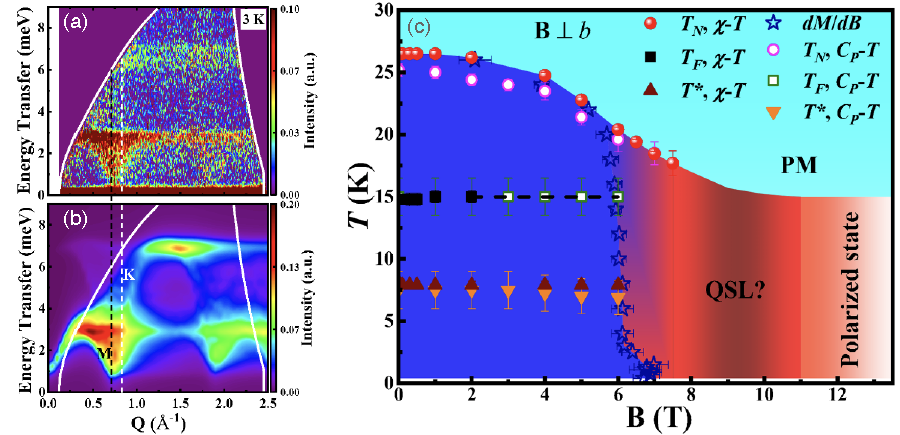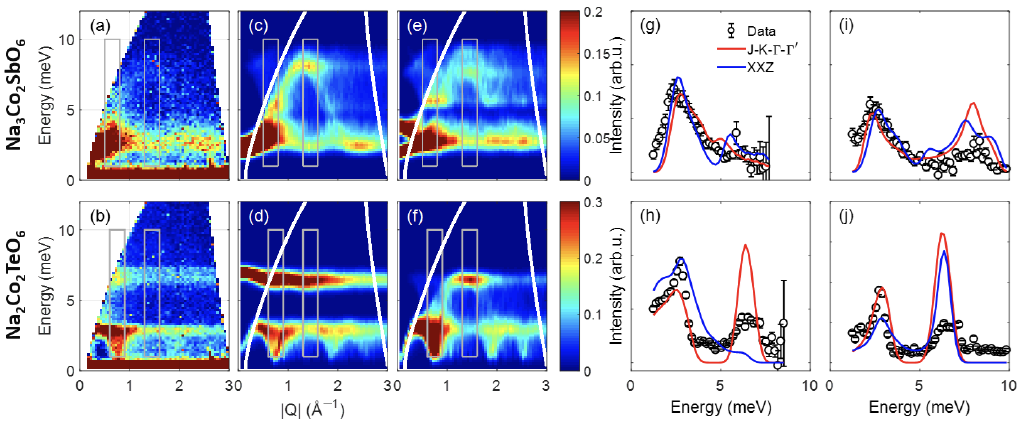◆ 研究成果
Field-induced quantum spin disordered state in spin-1/2 honeycomb magnet Na2Co2TeO6
Magnets with significant spin-orbital couplings (SOCs) have become a new playground for quantum magnetism in recent years thanks to their potential of hosting novel quantum phases of matter. A prominent example is the Kitaev model, an exactly solvable spin model that features a topological quantum spin liquid (QSL) ground state. Microscopically, such a model could emerge from magnetic insulators with competing, spin anisotropic exchange interactions. The essential prerequisites are that (a) the magnetic ions have spin-orbital entangled, Kramers degenerate ground states and (b) they are arranged on a suitable lattice, with the two-dimensional (2D) honeycomb lattice being the simplest example. So far, the search for the material incarnations of the Kitaev model has been focused on 4d/5d transition mental based systems due to their relatively strong SOCs. The examples include H3LiIr2O6, α-Li2IrO3, α-Na2IrO3, and α-RuCl3. To describe these materials, the Kitaev model has been extended to a generalized Heisenberg-Kitaev (H-K) model with five symmetry-allowed terms, Kitaev term K, off-diagonal symmetric exchange term G and Γ′, nearest-neighbor (NN) Heisenberg coupling J, and the third NN Heisenberg coupling J3.
More recently, the theoretical studies suggest that Kitaev physics could also be found in honeycomb magnets made of cobalt, a 3d transition metal. A pertinent material is the honeycomb magnet Na2Co2TeO6 (NCTO). We have used a combination of heat capacity, magnetization, electron spin resonance measurements alongside inelastic neutron scattering (INS) to study NCTO's quantum magnetism, and we have found a field-induced spin disordered state in an applied magnetic field range of 7.5 T < B (⊥ b-axis) < 10.5 T. The INS spectra were also simulated to tentatively extract the exchange interactions. As a 3d-magnet with a field-induced disordered state on an effective spin-1/2 honeycomb lattice, NCTO expands the Kitaev model to 3d compounds, promoting further interests on the spin-orbital effect in quantum magnets. Its origin, in addition to the related spin structure and spin dynamics, calls for future experimental work on single crystals and theoretical studies.
This work was published on Nature Communications [1]. The INS experiment was performed at the MLF of J-PARC under a user program (proposal No. 2019B0350).
[1] Gaoting Lin, Jaehong Jeong, Yao Wang, Qing Huang, Takatsugu Masuda, Shinichiro Asai, Shinichi Itoh, Gerrit Günther, Margarita Russina, Zhilun Lu, Jieming Sheng, Le Wang, Chaebin Kim, Jiucai Wang, Guohua Wang, Qingyong Ren, Chuanying Xi, Wei Tong, Langsheng Ling, Zhengxin Liu, Liusuo Wu, Jiawei Mei, Haidong Zhou, Zhe Qu, Je-Geun Park, Yuan Wan, and Jie Ma, Nature Commun. 12, 5559 (2021): https://doi.org/10.1038/s41467-021-25567-7.

図1. (a) Powder INS using 11.4 meV incident neutron for NCTO at 3 K on spectrometer HRC. The high-temperature data (95 K) was subtracted as background and the thermal effect was simulated by the Bose factor; (b) The calculated powder-averaged scattering including the magnetic form factor with K = Γ = 0.125 meV, J = -2.325 meV, and J3 = 2.5 meV. The black and white dashed lines label M and K points at the first Brillouin zone with Q = 0.72 and 0.83 Å−1, respectively; (c) Temperature-magnetic field phase diagram for NCTO. The stars symbol the first-ordered phase boundary. The color background is used only as a simple guide.
Antiferromagnetic Kitaev interaction in Jeff=1/2 cobalt honeycomb materials Na3Co2SbO6 and Na2Co2TeO6
Realizing the Kitaev model and its related spin liquid in a natural system is important for quantum magnetism research [1]. To realize the Kitaev model in a real system, the spin-orbit entanglement is essential, making the exchange anisotropic. So, present studies are focused on 4d and 5d compounds with strong spin-orbit coupling. But recent studies reveal that the 3d Co2+ system can also have Kitaev interaction despite small spin-orbit coupling [2]. And recently, considerableattention has been shifted to the case with antiferromagnetic (AFM) Kitaev interaction. Interestingly, a theoretical study revealed that only the AFM Kitaev model shows an additional topological spin liquid state with a magnetic field [3]. Although AFM Kitaev candidates have not been identified yet, this exciting possibility has already attracted much interest.
In this work, we conclude that Na3Co2SbO6 and Na2Co2TeO6 are new honeycomb cobalt-based systems with AFM Kitaev interaction by carrying out inelastic neutron scattering experiments and subsequent analysis [4]. The spin-orbit excitons observed at 20-28 meV in both compounds strongly support the idea that Co2+ ions of both compounds have a spin-orbital entangled Jeff=1/2 state. Furthermore, we found that a generalized Kitaev-Heisenberg Hamiltonian can describe thespin-wave excitations of both compounds with additional 3rd nearest-neighbor interaction. Our best-fitting parameters show significant AFM Kitaev terms and off-diagonal symmetric anisotropy terms of a similar magnitude in both compounds. We also found a strong magnon-damping effect at the higher energy part of the spin waves, entirely consistent with observations in other Kitaev magnets.
Our work suggests Na3Co2SbO6 and Na2Co2TeO6 as rare examples of the AFM Kitaev magnets based on the systematic studies of the spin waves and analysis. This work will be published in the Journal of Physics: Condensed Matter [4]. The neutron-scattering experiment at HRC was performed with the J-PARC under the user proposal program (2019B0350).
[1] A. Kitaev, Ann. Phys. 321, 2-111 (2006).
[2] H. Liu and G. Khaliullin, Phys. Rev. B 97, 014407 (2018).
[3] C. Hickey and S. Trebst, Nature Commun. 10, 530 (2019).
[4] Chaebin Kim, Jaehong Jeong, Gaoting Lin, Pyeongjae Park, Takatsugu Masuda, Shinichiro Asai, Shinichi Itoh, Heung-Sik Kim, Haidong Zhou, Jie Ma, and Je-Geun Park, J. Phys. Condens. Matter. 34, 045802 (2021) : https://doi.org/10.1088/1361-648X/ac2644

図2. (a),(b) Magnon spectra of Na3Co2SbO6 (NCSO) and Na2Co2TeO6 (NCTO) measured at T=3.2 K with Ei=16.54 meV. Calculated powder magnon spectra (c),(d) using the generalized Kitaev-Heisenberg model and (e),(f) using the XXZ model with the best-agreement parameters. Comparison of constant-Q cuts, (g),(i) integrated over Q=[0.5 0.8] and [1.3 1.6] Å-1 for NCSO and (h),(j) integrated over Q=[0.6 0.9] and [1.3 1.6] Å−1 for NCTO.
◆ 論文等
◆ 論文等